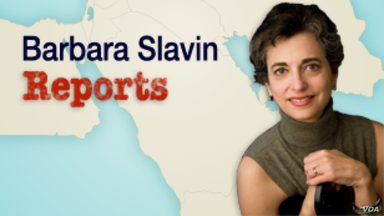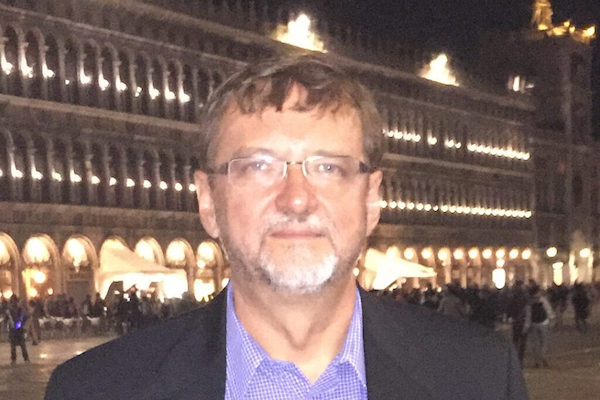Expert Who Gave Anti-Iran Regime Protesters the Finger Returns to Greta Van Susteren Voice of America TV
USAGM WATCH COMMENTARY
On January 15, 2020, Barbara Slavin returned to the Voice of America by appearing in “Plugged In with Greta Van Susteren” Voice of America TV news program. She was welcomed back by VOA despite her unusual behavior toward anti-Iranian regime demonstrators in an incident in New York in 2017 when she was filmed giving them the finger.
The dysfunctional and “practically defunct” (Secretary Clinton in 2013) U.S. Agency for Global Media (USAGM) became aware of the incident when the current Republican chairman of the BBG’s bipartisan board, President and CEO of the Hudson Institute Kenneth Weinstein @KenWeinstein, retweeted in July 2017 a video recorded by anti-Iran regime demonstrators which showed former longtime Voice of America (VOA) guest commentator and former VOA guest program moderator Barbara Slavin making what appears to be an obscene gesture toward Iranian refugees and Iranian Americans who were protesting the visit to New York of the Iranian foreign minister. When Dr. Weinstein re-tweeted the video, the agency was called the Broadcasting Board of Governors (BBG). In 2018, it changed its name to USAGM.
The anti-regime demonstrators were shouting “Shame on You” after recognizing the VOA personality who has been a strong advocate for the nuclear deal with Iran signed by the Obama Administration. She later apologized in a tweet for some of her behavior toward the anti-Iran regime demonstrators during the July 2017 incident in New York.
This is @barbaraslavin1 showing her fingers 2us. How professional!! @AP @AFP @Reuters @CNN #FreeIran #journalism @FoxNews @CNBC @USATODAY pic.twitter.com/3S3k8whFXg
— Shirin Nariman (@ShirinNariman) July 18, 2017
On January 15, 2020, Barbara Slavin returned to the Voice of America by appearing in “Plugged In with Greta Van Susteren” VOA TV news program.
Slavin criticized the Trump Administration over its current position on Iran.
BARBARA SLAVIN: I think actually actions taken by the Trump administration are probably pushing off chances for regime change.
When a country is under threat under existential threat, as Iran feels it is now from the UnitedStates, it tends to make more hardline faction stronger, it tends to make a regime more rigid
So I think it’s very unlikely that it’s going to lead to regime change in the near future
GRETA VAN SUSTEREN: I found it fascinating but obviously from a, you know troubled point of view, is that there was, right after the killing of Soleimani, there was death to America. Basically the protest was anti-United States. Then almost instantly when that plane went, was shot down, and the Iranians were said to have been lying about, suddenly it flipped right away. It would became anti-regime, death to the regime.
BARBARA SLAVIN: You know it’s possible for people to dislike both the Trump administration and their own government, so I think what we saw in the initial demonstrations was a kind of nationalistic outpouring. Whatever we may think about Qasem Soleimani, he was considered to be a hero to many in Iran who did his killing outside the country fighting ISIS rather than repressing people inside. Also the way he was killed, arriving at Baghdad Airport, by an American drone, I think when you combine that with threats that President Trump had made toward Iran Iran’s cultural sites–you remember his comment about 52 sites, including cultural sites that might be under attack–I think this caused a genuine outpouring on the part of many people.
Greta Van Susteren did not question or challenge any of Barbara Slavin’s assertions, including Slavin’s statement that “Qasem Soleimani, he was considered to be a hero to many in Iran who did his killing outside the country fighting ISIS rather than repressing people inside.” At the very least, Greta Van Susteren could have pointed out that Qasem Soleimani served a highly repressive regime and helped to keep it in power.
Barbara Slavin at VOA
The person seen showing the finger to anti-Iran regime demonstrators in the 2017 video, was identified by them as Barbara Slavin @barbaraslavin1. She later moderated a Voice of America broadcast dealing partly with Iran, but subsequently it appears that she has not participated frequently in new VOA programs until the Greta Van Susteren show on “Iran, Protests, and the Ukrainian Plane It Shot Down,” which aired on January 15, 2020.
Immediately after the 2017 incident in New York, Barbara Slavin accused the anti-Iran regime demonstrators of being representatives of a terrorist organization and in one tweet called them “nuts.” Photos show that many of the demonstrators were Iranian and Iranian American women.
Image showing women holding the sign “NO PLACE AT CFR [Council on Foreign Relations] FOR IRAN’S TERRORIST REGIME FOREIGN MINISTER” from: NCRIWomen’sCommittee @womenncri Jul 18 #Iran regime’s FM was greeted well upon his visit to NY! The call is #FreeIran.
Users of the VOA News website may still be confused as to the exact role Barbara Slavin plays in VOA programs. Her bio page on the VOA website includes her photo with the caption: “Barbara Slavin Reports.” She is, however, a commentator rather than a reporter. VOA is showing that she has produced more than 80 commentaries and reports for the Voice of America from July 2013 to April 2015 in addition to hosting various VOA programs. Some of these entires are marked as “Column” or “Opinion,” but others seem to be presented as news reports. Each one in the VOA archives includes her image with “Barbara Slavin Reports” caption. In addition, Barbara Slavin is listed multiple times as a moderator of VOA program “Issues in the News” from 2015 until at least August 18, 2017, days after the incident in New York. This bio for Barbara Slavin was on the VOA News website as of March 1, 2020.
Barbara Slavin is a senior fellow at the Atlantic Council’s South Asia Center and a correspondent for Al-Monitor.com, a website specializing in the Middle East. She is the author of a 2007 book, Bitter Friends, Bosom Enemies: Iran, the US and the Twisted Path to Confrontation, and is a regular commentator on U.S. foreign policy and Iran on NPR, PBS, C-SPAN and the Voice of America.
A career journalist, Slavin previously served as assistant managing editor for world and national security of The Washington Times, senior diplomatic reporter for USA TODAY, Cairo correspondent for The Economist and as an editor at The New York Times Week in Review.
She has traveled to Iran nine times, most recently for the inauguration of Iranian President Hassan Rouhani. Slavin also served as a public policy scholar at the Woodrow Wilson International Center for Scholars and as a senior fellow at the U.S. Institute of Peace, where she researched and wrote the report Mullahs, Money and Militias: How Iran Exerts Its Influence in the Middle East.
AFPC Study of VOA Persian and Radio Farda
In September 2019, Ilan Berman, senior vice president of the American Foreign Policy Council in Washington, DC, published an op-ed in The Washington Times on what he and many other critics see as the failure of Persian-language media outreach to Iran by the U.S. Agency for Global Media. Berman focused his criticism on the Voice of America Persian Service.
For years, VOA has been the target of scathing criticism from Iran-watchers and opposition activists alike for its failure to properly explain U.S. policy, its perceived bias in favor of the Iranian regime, and widespread internal mismanagement and corruption. VOA’s credibility has suffered greatly as a result, with the service becoming overshadowed by foreign counterparts like BBC Persian and Manoto, which are uniformly viewed as being both more credible and more dynamic.
So far, the U.S. government’s official Persian-language outreach has fallen far short of that mark. And as a result, it remains at best a peripheral part of America’s approach to Iran. At worst, it serves as a clear detriment to it.
The White House should make it a priority to change this sorry state of affairs, and do so without delay. The long-term success of its Iran strategy could very well depend on it.
In 2017, Berman and other AFPC experts prepared a study of Voice of America [VOA Persian Service] and Radio Free Europe / Radio Liberty [RFE/RL Radio Farda] Iran coverage. The study was commissioned by the Broadcasting Board of Governors. Experts concluded:
This dynamic, on the whole, perpetuated to audiences the appearance of pro-regime propaganda, rather than objective reporting, on the part of both the VOA and Farda.
AFCP
AMERICAN FOREIGN POLICY COUNCIL U.S. PERSIAN MEDIA STUDY
Final Synthesis Report
October 6, 2017
AFCP experts also concluded:
More broadly, however, coverage of the JCPOA on both the Voice of America and Radio Farda was found to consistently lack broader context. Little to no effort was made, either by hosts or journalists, to explain the limitations of the agreement itself, or the detrimental side effects generated by it, or the implications of the deal for U.S. policy in the broader region. Similarly, in the media reports reviewed, only minimal effort was made to explain the reasoning and rationale behind the Trump administration’s different, and far more negative, view of the agreement. Simply put, Iranians were told in detail that the Obama White House supported the agreement, and why. They have not been afforded the same explanations of current administration policy.
These violations of the VOA Charter and the VOA Journalistic Code occurred under the management team led by former USAGM CEO John Lansing, and still current (as of March 1, 2020) VOA director Amanda Bennett and her deputy Sandy Sugawara. All of them were appointed to their positions during the previous administration.




